In 2019, fieldwork in Old Sikyon was carried out from late June to the end of July and included archaeological excavations, a geoarchaeological survey and the study of architectural spolia.
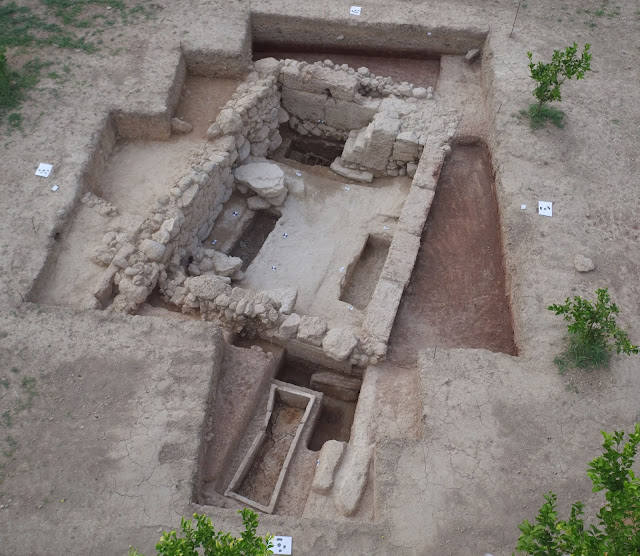 |
Drone picture of Trench 3A from southeast with the ‘Heroon’ and its surroundings
[Credit: Hellenic Ministry of Culture] |
The excavations concentrated on six trenches in four different fields, four of which had already been started during previous seasons. In Field 3 north-east of the supposed city centre, the excavation of a late Classical building was continued in order to reveal a room to its full depth as well as part of its surroundings. The partly underground rectangular room (6.30 x 4.40 m) was made of walls of monumental blocks on two sides and of walls of mixed material on its two other sides and was originally covered with a tiled roof. Stairs led down into it from its north-eastern corner and maybe also from its south-western corner.
In direct contact with the bottom of the north, west and east walls, three Archaic graves (ca. 610-555 BC) cut into the bedrock were revealed. They contained multiple burials (men, women and children) and were marked by particular stones, but only one of them featured grave goods, including nine aryballoi and one askos (small vases) in the form of a hare dated to the early to middle Corinthian period. The building had at least two different construction phases and went probably out of use in the 2nd half of the 4th cent. BC, perhaps in connection with the destruction of the city in the year 303 BC.
On the base of the uncovered remains including the large amounts of pottery and various figurines found within this room, it can be interpreted as a sort of Heroon, where an ancestors’ cult and maybe also the veneration of chthonic deities were practiced. South of this room, a grave of the 5th cent. BC was uncovered, which contained as the only grave goods the remains of the shoes of the deceased, in the form of two iron frames, which originally were nailed to wooden soles.
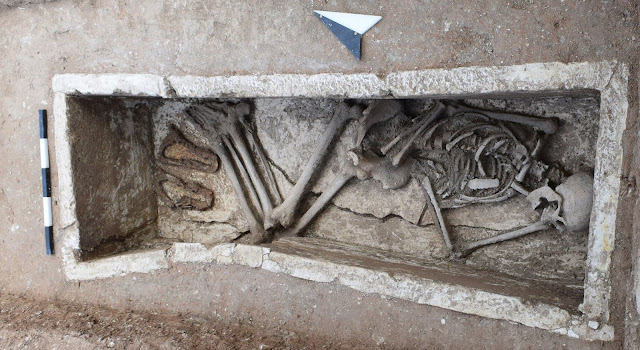 |
Grave from the 5th cent. BC next to the ‘Heroon’ in Trench 3A, with remains
of the shoes of the deceased [Credit: Hellenic Ministry of Culture] |
In Field 7 further to the northeast in the outskirts of the city, a Classical or Early Hellenistic grave monument (ca. 350-300 BC) was further revealed (Trench 7C). Its architectural front of 4,60 m length was oriented along a road on its northern side. Only the lowest course over the foundation is preserved consisting of large limestone blocks connected by Z-clamps and featuring a cyma reversa.
On the western and eastern sides, two symmetrically placed blocks mark the limits of the monument. Two stone cist graves with a single burial of a grown-up in each were excavated within the monument, yielding rich and well-preserved grave goods: fine drinking cups, lidded lekanis bowls, miniature vases, lamps, a silver coin and iron strigiles.
In a higher level, the burned remains of a grave ritual were found, including dozens of fragments of human and animal figurines and numerous shapes (e.g. bowls, plates and pouring vessels) of a special type of red-slipped pottery stamped with a characteristic egg decoration. This type of pottery was probably produced locally between 340 and 275 BC. Just next to the monument, a deposit from the 5th cent. BC including six Attic lekythoi (one of which white-ground) and a kotyle was revealed, indicating the funeral use of this area at least from this time onwards.
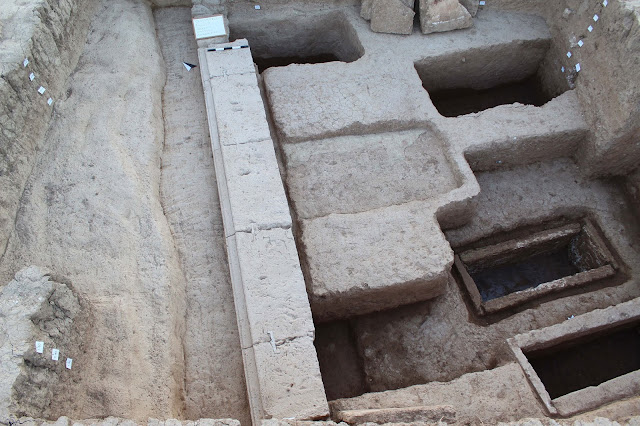 |
The grave monument from the late Classical or early Hellenistic period in Trench 7C
[Credit: Hellenic Ministry of Culture] |
50 m northwest of this grave monument in an area outside the borders of the settlement, Classical building remains were found (Trench 7A), which, judging from the resistivity survey, could belong to a large building complex of ca. 18 x 20 m. A large room (2.50 x 2.50 m) and an adjacent smaller, corridor-like storage room (ca. 2.90 x 0.90 m) were completely revealed, while another room to the south was only partly excavated. On the base of many large fragments of storage vessels, the few fragments of fine-ware pottery, loom weights and coins might indicate an extra-urban workshop or agricultural context.
In Field 8 in the south-eastern part of the town, a new trench was opened on top of a large positive linear anomaly found with geomagnetic prospection, which could have indicated the trace of the city wall. Instead, part of a monumental late Classical building and in direct connection with it an early Hellenistic grave covered with tiles were excavated. The building might have had a public, cultic or funeral function.
Directly southeast of it, a four-sided floor-like surface was probably used for workshop activities. In the early Byzantine period, the area was used in an agricultural context, which is indicated by a large pithos with a preserved diameter of 1.40 m set up in an (indoor or outdoor) area bordered by walls. Also the large amount of burnt olive stones found in the corresponding layers and a large olive press in the neighbouring field indicate the production of olive oil.
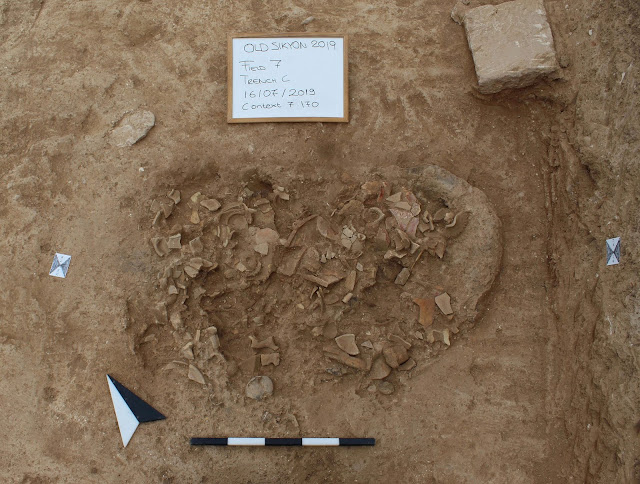 |
Remains of a grave ritual in Trench 7C with burned figurines and pottery
[Credit: Hellenic Ministry of Culture] |
Private house remains from the 2nd half of the 4th cent. BC found in 2018 in Field 9 (Trench 9A) in the core of the city were further investigated this year. It was revealed that the walls of this habitation context were dug into a large floor from a slightly earlier phase and that floors of stamped earth belong to the phase of the walls.
Remains of earlier constructions were not found in this trench. An extension of the trench to the west (after a gap of 3 m due to a modern water pipe) yielded the continuation of the building complex in several walls belonging to different construction phases, which witness of continued domestic activity including reuse and rebuilding trough a longer period of time.
Another trench (9B) was opened on the south-western end of the same field and revealed the first archaic construction remains ever found in the area of Old Sikyon. The four Archaic walls are arranged around an area which could have formed a courtyard. In the Classical period, more walls and a drain made of roof-tiles were constructed, which were covered in the late Classical/early Hellenistic period again by a larger drain carefully made of Π-shaped stone blocks.
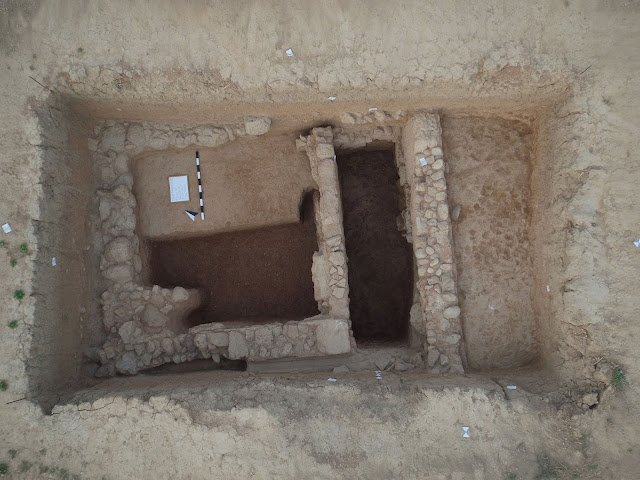 |
Drone picture of Trench 7B with Classical building remains
[Credit: Hellenic Ministry of Culture] |
In the eastern part of the trench, a boulder was installed earlier in the Classical period and surrounded by miniature vessels dating mainly to the 5th cent. BC, which indicates cultic activity. In the Hellenistic period the Π-shaped drain and its surroundings were covered and two perpendicular walls decorated with red- and yellow-painted stucco with a mortared pebble floor between them were installed. This representative private room indicates the sporadically continued use of the area for habitation also after the destruction of the old city.
3D documentation of the excavations was applied again by Toke Hansen (Museum of South-Eastern Denmark). For large-scale archaeobotanical studies, a particularly high number of 290 soil samples were collected and processed this year. In addition to that, samples for starch analysis were collected, particularly fragments from cooking and storage vessels, in order to investigate their content.
The 2019 field season was exceptionally rich in finds, many of excellent character, which were again processed at the Ephorate’s depot at Archaia Sikyona/Vasiliko. From Trench 3A particularly the Archaic grave goods have to be emphasized, but also the iron shoe frames as a special find. Furthermore, this trench yielded a high number of complete or partly complete vessels of all types, ranging from transport amphorae, vessels used for preparation and cooking of food and drinking cups in particular.
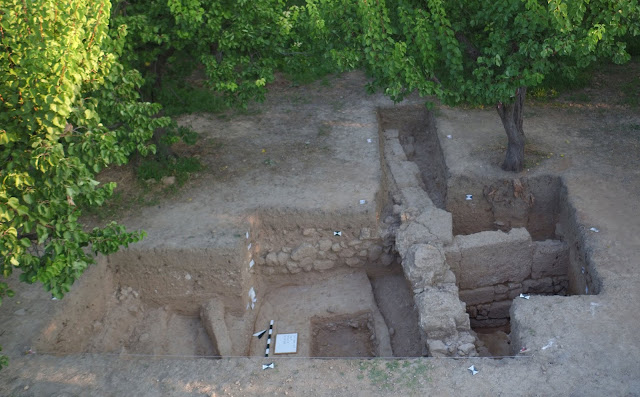 |
Part of a monumental building from the late Classical period in Trench 8A
[Credit: Hellenic Ministry of Culture] |
From Trench 7A, the high amounts of storage vessels stand out, while the late Classical grave goods of Trench 7C along with the Attic lekythoi and the remains of a ritual pyre represent particularly excellent material, providing a proof for the existence of an independent and high-quality Sikyonian pottery production.
The grave goods from Trench 8A form an interesting Hellenistic ensemble. Trench 9B yielded a few fragments of Helladic pottery and many impressive fine-ware fragments from the Geometric, Archaic and Classical periods, indicating continuous activity in this area over a long period.
Also in terms of coins, the season was particularly yielding. They were studied again by Michael Ierardi (Bridgewater State University). All in all, 24 coins were found, most of which are from Sikyon (one from the 5th cent. BC and five to six from the 4th c. BC), others from other Greek states including Corinth, Salamis (Cyprus), Mykonos and Syracuse.
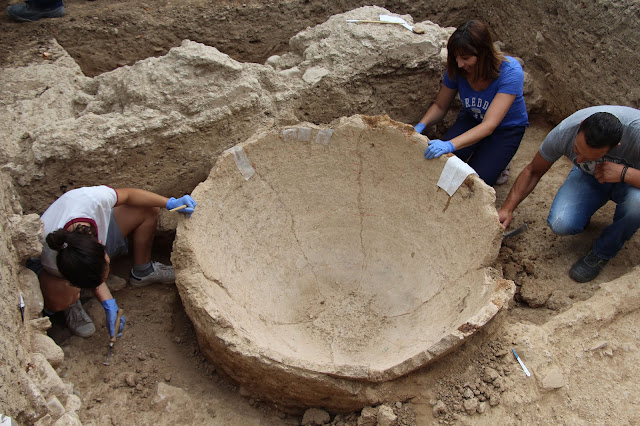 |
Removal of the large Byzantine pithos from Trench 8A
[Credit: Hellenic Ministry of Culture] |
The stone objects were again studied by Pernille Foss (University of Copenhagen), some skeletons were investigated by Mette Arenfeldt (Museum of Southern Jutland) and the conservation of the most important finds was, as in previous years, taken over by the conservator Angeliki Kandri. In the framework of a Master’s thesis, Melanie Nguyen (University of Regensburg) studied the spolia from the former church of Agia Varvara in the southwest of the study area.
The geoarchaeological survey was continued by Chris Hayward (University of Edinburgh), who identified more rock varieties used in excavated structures and undertook further systematic surveys of exposures of bedrock within the Sikyonia to identify the types and exploitable volumes of construction stone available and traces of ancient quarrying. The results suggest that the high-quality oolitic limestone used in Old Sikyon originated from Corinthian, rather than Sikyonian sources, while calcarenite suitable for ashlar masonry is present near to the city’s location and plentiful supplies of conglomerate and local calcarenites were available for rubble construction.
The results of the 2019 campaign greatly enhance our knowledge of the private architecture of different phases of Old Sikyon including home decor and storage facilities, and of workshop arrangements. Moreover, a great range of important information about burial rites and practices over time, grave rituals, ancestors’ cult and burial monuments was collected.
 |
Drone picture of Trench 9A with domestic structures
[Credit: Hellenic Ministry of Culture] |
After the results of the 2019 season and the range of information gained in the field seasons of the first phase of the project, it would be particularly desirable to continue the research in Old Sikyon in a second project phase, in order to clarify the remaining important questions of topography, which concern the different parts of fortification, the more detailed form of the harbour and the harbour town and the inner organisation of the city including the city centre and the street grid, in order to gain a more thorough insight into Old Sikyon’s material culture, including the famous Sikyonian sculpture and local pottery, and in order to investigate the social and cultural practices of life in the old city over time.
The rich material collected in the field seasons 2015-2019 represents an excellent base for such studies, but needs to be complemented for both, a broader overview and a deeper insight.
Credit: Danish Institute at Athens [January 21, 2020]











































